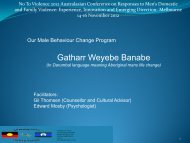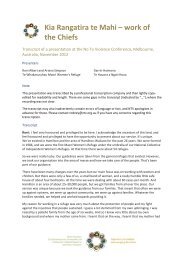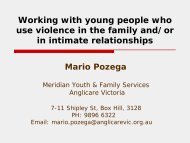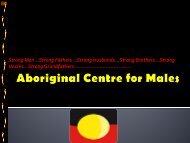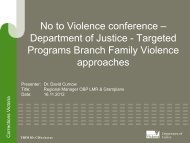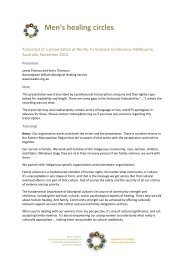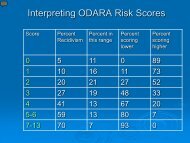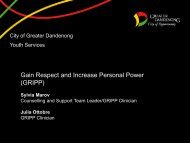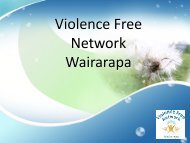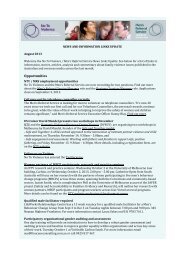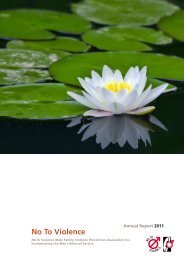Issues/services for same-sex attracted people in relation to domestic violence
Read the workshop document - No To Violence
Read the workshop document - No To Violence
- No tags were found...
Create successful ePaper yourself
Turn your PDF publications into a flip-book with our unique Google optimized e-Paper software.
<strong>Issues</strong>/<strong>services</strong> <strong>for</strong> <strong>same</strong>-<strong>sex</strong><br />
<strong>attracted</strong> <strong>people</strong> <strong>in</strong> <strong>relation</strong> <strong>to</strong><br />
<strong>domestic</strong> <strong>violence</strong><br />
Summarised from a workshop of the <strong>same</strong> name at the No To Violence<br />
Conference, Melbourne, Australia, November 2012<br />
Introduction<br />
This paper draws on the experience of Nicci Rossel and Trish Thompson, as facilita<strong>to</strong>rs/coord<strong>in</strong>a<strong>to</strong>rs<br />
of Revision<strong>in</strong>g, a men's behaviour change program <strong>for</strong> men <strong>in</strong> <strong>same</strong>-<strong>sex</strong> <strong>relation</strong>ships, run by the<br />
Vic<strong>to</strong>rian AIDS Council/Gay Men's Health Centre. It is also <strong>in</strong><strong>for</strong>med by contributions from Maxwell<br />
Clarke, a <strong>sex</strong>ual assault counsellor /advocate and supervisor of Men’s Referral Service (Vic<strong>to</strong>ria)<br />
telephone counsellors.<br />
This paper uses the term '<strong>domestic</strong> <strong>violence</strong>' rather than 'family <strong>violence</strong>'. In Nicci's experience, this<br />
term has had more traction, as homophobia has led <strong>to</strong> many <strong>people</strong> <strong>in</strong> the LGBTI community <strong>to</strong> feel<br />
that 'family' is only <strong>for</strong> straight <strong>people</strong>.<br />
His<strong>to</strong>ry of the Revision<strong>in</strong>g program and other work on <strong>same</strong>-<strong>sex</strong> <strong>domestic</strong> <strong>violence</strong><br />
When she started at VAC/GMHC, Nicci already had a lot of experience as a couples counsellor and<br />
work<strong>in</strong>g <strong>in</strong> the areas of child <strong>sex</strong>ual abuse and adult <strong>sex</strong>ual assault. She noticed that VAC/GMHC<br />
counsell<strong>in</strong>g staff didn't tend <strong>to</strong> work with couples, and so she started <strong>to</strong> explore the possibilities <strong>for</strong><br />
offer<strong>in</strong>g couples counsell<strong>in</strong>g with<strong>in</strong> the service. Dur<strong>in</strong>g that process, it became apparent that men<br />
were self-referr<strong>in</strong>g <strong>for</strong> counsell<strong>in</strong>g and us<strong>in</strong>g their counsell<strong>in</strong>g sessions <strong>to</strong> talk about their<br />
<strong>relation</strong>ship difficulties, but not discuss<strong>in</strong>g <strong>violence</strong>. For most men, says Nicci, "No-one was talk<strong>in</strong>g<br />
about <strong>violence</strong> ... it wasn't <strong>in</strong> their vocabulary … they had no conception that what was go<strong>in</strong>g on <strong>in</strong><br />
their <strong>relation</strong>ships was <strong>violence</strong>."<br />
The program commenced <strong>in</strong> 2004. Its goals are <strong>to</strong>:<br />
• work <strong>to</strong>wards improv<strong>in</strong>g the quality of <strong>relation</strong>ships amongst gay and bi<strong>sex</strong>ual men<br />
• work <strong>to</strong>wards try<strong>in</strong>g <strong>to</strong> reduce the <strong>in</strong>cidence of HIV and improve the wellbe<strong>in</strong>g of the gay<br />
and bi<strong>sex</strong>ual <strong>relation</strong>ships and communities.<br />
VAC/GMHC is a member of No To Violence and so Revision<strong>in</strong>g is run <strong>in</strong> a manner consistent with the<br />
standards <strong>for</strong> all Vic<strong>to</strong>rian men's behaviour change programs. It is open <strong>to</strong> men who identify as gay<br />
or bi<strong>sex</strong>ual, or who are <strong>in</strong> a <strong>same</strong>-<strong>sex</strong> <strong>relation</strong>ship.<br />
The program holds offers regular partner contact, as well as partner nights. The latter are extremely<br />
important <strong>in</strong> nam<strong>in</strong>g the <strong>domestic</strong> <strong>violence</strong> and talk<strong>in</strong>g about the rights of <strong>same</strong>-<strong>sex</strong> <strong>attracted</strong> men<br />
<strong>to</strong> be safe from <strong>violence</strong>.
While there have a few short-term programs <strong>for</strong> women <strong>in</strong> <strong>same</strong>-<strong>sex</strong> <strong>relation</strong>ships elsewhere around<br />
the state, there are no permanent programs <strong>for</strong> women. VAC/GMHC has a brochure <strong>for</strong> lesbians,<br />
written <strong>in</strong> collaboration with Domestic Violence Resource Centre.<br />
In addition <strong>to</strong> the Revision<strong>in</strong>g program, VAC/GMHC has developed a tra<strong>in</strong><strong>in</strong>g program aimed at<br />
workers <strong>in</strong> the field <strong>to</strong> address the lack of understand<strong>in</strong>g <strong>in</strong> the family <strong>violence</strong> sec<strong>to</strong>r regard<strong>in</strong>g<br />
<strong>same</strong>-<strong>sex</strong> <strong>domestic</strong> <strong>violence</strong>. Both Nicci and Trish have also worked with the gay press <strong>to</strong> try <strong>to</strong><br />
<strong>in</strong>crease community recognition of <strong>domestic</strong> <strong>violence</strong>.<br />
There has been other work on <strong>same</strong>-<strong>sex</strong> <strong>domestic</strong> <strong>violence</strong> <strong>in</strong> other states. ACON <strong>in</strong> NSW has a<br />
website (www.anothercloset.com.au) and offers <strong>in</strong>dividual counsell<strong>in</strong>g. In Queensland, there has<br />
been a collaboration between a range of service providers <strong>to</strong> produce a booklet on <strong>same</strong>-<strong>sex</strong><br />
<strong>domestic</strong> <strong>violence</strong>, published by Queensland Association <strong>for</strong> Healthy Communities. A small group of<br />
men <strong>in</strong> Perth also worked around the issue of <strong>domestic</strong> <strong>violence</strong> <strong>in</strong> <strong>same</strong>-<strong>sex</strong> <strong>relation</strong>ships; while the<br />
group no longer exists, its work is be<strong>in</strong>g carried on by Communicare, which cont<strong>in</strong>ues <strong>to</strong> ma<strong>in</strong>ta<strong>in</strong> a<br />
comprehensive website (www.ssdag.org.au).<br />
Internationally, Maxwell visited Bos<strong>to</strong>n, USA <strong>to</strong> <strong>in</strong>vestigate <strong>services</strong> <strong>for</strong> <strong>same</strong>-<strong>sex</strong> <strong>attracted</strong> men.<br />
There, the gay <strong>domestic</strong> <strong>violence</strong> phone l<strong>in</strong>e is open every day and operates its own refuge. Same<strong>sex</strong><br />
<strong>attracted</strong> men also have access <strong>to</strong> straight refuges (and the gay refuge will also take straight<br />
clients). Participation <strong>in</strong> men's behaviour change groups and counsell<strong>in</strong>g <strong>in</strong> Bos<strong>to</strong>n is almost entirely<br />
court mandated.<br />
Key issues <strong>in</strong> men's behaviour change work with <strong>same</strong>-<strong>sex</strong> <strong>attracted</strong> men<br />
Much of the content of the work is similar <strong>to</strong> any MBCP, however there are some differences.<br />
Firstly, there is a significant and deep focus on how <strong>in</strong>ternalised homophobia affects men's<br />
<strong>relation</strong>ships. This issue first came <strong>to</strong> prom<strong>in</strong>ence <strong>in</strong> the VAC/GMHC's <strong>in</strong>duction process <strong>for</strong> its<br />
volunteer counsellors, and has s<strong>in</strong>ce been recognised as one of the most dom<strong>in</strong>ant fac<strong>to</strong>rs <strong>in</strong><br />
<strong>violence</strong> <strong>in</strong> <strong>same</strong>-<strong>sex</strong> <strong>relation</strong>ships. Nicci comments that:<br />
"Homophobia is someth<strong>in</strong>g we are all exposed <strong>to</strong> from a young age; it's not someth<strong>in</strong>g any<br />
of us can get away from. We all <strong>in</strong>ternalise homophobic messages and this affects our<br />
perceptions of homo<strong>sex</strong>uality and <strong>same</strong>-<strong>sex</strong> <strong>relation</strong>ships … So we need <strong>to</strong> understand that<br />
homophobia is a lens through which <strong>people</strong> <strong>in</strong> the queer communities see themselves. It is<br />
not an excuse <strong>for</strong> <strong>violence</strong>, but is an added fac<strong>to</strong>r <strong>in</strong> the k<strong>in</strong>ds of <strong>violence</strong> we see."<br />
Internalised homophobia is not restricted only <strong>to</strong> <strong>people</strong> who are not out, or only recently out. In<br />
her work, Nicci has found that even <strong>people</strong> who were "very out and proud" might still feel significant<br />
levels of self-loath<strong>in</strong>g.<br />
Internalised homophobia also affects help-seek<strong>in</strong>g practices, <strong>in</strong> part because perpetrat<strong>in</strong>g or<br />
experienc<strong>in</strong>g <strong>violence</strong> can be seen as just another level of shame. Says Nicci, "They already felt<br />
shamed because of their <strong>sex</strong>uality; they felt that <strong>people</strong> would see it as br<strong>in</strong>g<strong>in</strong>g it on themselves.<br />
There are so many th<strong>in</strong>gs about be<strong>in</strong>g part of the queer community that the straight community look<br />
down on them <strong>for</strong>, why talk about another?"<br />
Feel<strong>in</strong>gs of not feel<strong>in</strong>g valued, not belong<strong>in</strong>g and not be<strong>in</strong>g seen are very common among <strong>people</strong> <strong>in</strong><br />
<strong>same</strong>-<strong>sex</strong> <strong>relation</strong>ships.<br />
No To Violence 2012 Australian Conference on Responses <strong>to</strong> Men's Domestic and Family Violence<br />
www.ntvconference.org<br />
Liv<strong>in</strong>g messages with<strong>in</strong> a dom<strong>in</strong>ant narrative: fem<strong>in</strong>ist child-centred practice Page 2 of 6
Of course, <strong>in</strong>ternalised homophobia is constantly re<strong>in</strong><strong>for</strong>ced by external homophobia. This is evident<br />
at all levels of society – from <strong>people</strong> <strong>in</strong> <strong>same</strong>-<strong>sex</strong> <strong>relation</strong>ships be<strong>in</strong>g unable <strong>to</strong> marry <strong>in</strong> Australia, <strong>to</strong><br />
the lack of <strong>services</strong> <strong>in</strong> the community <strong>for</strong> <strong>same</strong>-<strong>sex</strong> <strong>attracted</strong> <strong>people</strong>.<br />
Case study<br />
Tom and Sean had been <strong>to</strong>gether <strong>for</strong> 12 years. Tom had come out as a gay man early <strong>in</strong> life.<br />
He had only had male partners and was extremely com<strong>for</strong>table with his <strong>sex</strong>ual identity. Sean,<br />
on the other hand, had come out much later <strong>in</strong> life. He had had several <strong>relation</strong>ships with<br />
women and was even engaged <strong>to</strong> a woman <strong>in</strong> his early 20s.<br />
Six years ago, Sean was violent <strong>to</strong>wards Tom. He subsequently participated <strong>in</strong> the Revision<strong>in</strong>g<br />
group and had <strong>in</strong>dividual counsell<strong>in</strong>g; but, while the <strong>relation</strong>ship cont<strong>in</strong>ued, an underly<strong>in</strong>g<br />
tension rema<strong>in</strong>ed.<br />
Sean and Tom sought couple’s counsell<strong>in</strong>g, <strong>in</strong> which they explored the attitudes of society<br />
<strong>to</strong>wards gay men and their own beliefs about healthy <strong>relation</strong>ships.<br />
Both Sean and Tom came from large, very generous and very <strong>in</strong>volved families. Typically,<br />
there were big celebrations around each sibl<strong>in</strong>g's marriage, but there had never been<br />
recognition or celebration of Sean and Tom's <strong>relation</strong>ship. In both families, Sean and Tom felt<br />
sidel<strong>in</strong>ed.<br />
Identify<strong>in</strong>g this dynamic helped Sean <strong>to</strong> confront his <strong>in</strong>ternalised homophobia. He revealed <strong>to</strong><br />
Tom that he had been the subject of homophobic verbal abuse from strangers just be<strong>for</strong>e he<br />
was violent <strong>to</strong> Tom. He acknowledged <strong>to</strong> Tom <strong>for</strong> the first time that be<strong>in</strong>g with him was<br />
sometimes a source of stress, because of his own homophobia.<br />
This was a turn<strong>in</strong>g po<strong>in</strong>t <strong>for</strong> the couple and highlights the importance of understand<strong>in</strong>g the<br />
role of <strong>in</strong>ternalised homophobia <strong>in</strong> <strong>same</strong>-<strong>sex</strong> <strong>domestic</strong> <strong>violence</strong>.<br />
A second issue <strong>in</strong> men's behaviour change work with <strong>same</strong>-<strong>sex</strong> <strong>attracted</strong> men is how <strong>to</strong> theorise or<br />
talk about <strong>violence</strong> <strong>in</strong> ways that make sense <strong>to</strong> them. Trish has found that gendered explanations of<br />
family <strong>violence</strong> haven't had much resonance, but that the power and control wheels have been<br />
immediately relevant <strong>to</strong> group participants.<br />
The level of self-motivation among group participants is usually high. Nicci comments, "I was<br />
surprised at the level of <strong>in</strong>terest. They were really self-motivated; they saw they had a problem and<br />
needed <strong>to</strong> do someth<strong>in</strong>g about it."<br />
Th<strong>in</strong>k<strong>in</strong>g about <strong>domestic</strong> <strong>violence</strong> <strong>in</strong> <strong>same</strong>-<strong>sex</strong> <strong>relation</strong>ships<br />
Research suggests that <strong>violence</strong> <strong>in</strong> <strong>same</strong>-<strong>sex</strong> <strong>relation</strong>ships occurs at about the <strong>same</strong> rate as <strong>in</strong> the<br />
general community. There are some tactics of <strong>violence</strong> that are different; but the <strong>for</strong>ms and effects<br />
of <strong>violence</strong> are pretty much the <strong>same</strong>.<br />
The LGBTI community has been slow <strong>to</strong> recognise <strong>domestic</strong> <strong>violence</strong> <strong>in</strong> <strong>same</strong>-<strong>sex</strong> <strong>relation</strong>ships, <strong>in</strong><br />
part because it has been seen as a straight issue. Typically, <strong>in</strong> both the LGBTI and straight<br />
communities, men are seen as perpetra<strong>to</strong>rs of <strong>violence</strong> (<strong>in</strong> straight <strong>relation</strong>ships) or able <strong>to</strong> defend<br />
themselves/not <strong>in</strong> need of protection (<strong>in</strong> <strong>same</strong>-<strong>sex</strong> <strong>relation</strong>ships). Women are always seen as<br />
victims; they are seen as '<strong>in</strong>capable' of <strong>violence</strong>.<br />
No To Violence 2012 Australian Conference on Responses <strong>to</strong> Men's Domestic and Family Violence<br />
www.ntvconference.org<br />
Liv<strong>in</strong>g messages with<strong>in</strong> a dom<strong>in</strong>ant narrative: fem<strong>in</strong>ist child-centred practice Page 3 of 6
Nicci notes that <strong>domestic</strong> <strong>violence</strong> workers who worked predom<strong>in</strong>antly from the fem<strong>in</strong>ist model of<br />
understand<strong>in</strong>g of <strong>domestic</strong> <strong>violence</strong> often found the notion of <strong>violence</strong> <strong>in</strong> <strong>same</strong>-<strong>sex</strong> <strong>relation</strong>ships<br />
challeng<strong>in</strong>g <strong>to</strong> this model and <strong>to</strong> their own ideas of practice. While it is critical <strong>to</strong> both acknowledge<br />
the importance of the fem<strong>in</strong>ist underp<strong>in</strong>n<strong>in</strong>gs <strong>for</strong> responses <strong>to</strong> family <strong>violence</strong> and respect the<br />
groundbreak<strong>in</strong>g work of generations of fem<strong>in</strong>ists, it is also important <strong>to</strong> recognise the reality that<br />
<strong>violence</strong> does occur <strong>in</strong> <strong>same</strong>-<strong>sex</strong> <strong>relation</strong>ships.<br />
Recognition of <strong>domestic</strong> <strong>violence</strong> <strong>in</strong> <strong>same</strong>-<strong>sex</strong> <strong>relation</strong>ships can be a relief <strong>for</strong> both victims and<br />
perpetra<strong>to</strong>rs of <strong>violence</strong>. The idea that <strong>in</strong>timate partner <strong>violence</strong> can happen irrespective of<br />
<strong>sex</strong>uality or gender opens the way <strong>for</strong> <strong>people</strong> <strong>to</strong> recognise that the <strong>violence</strong> isn't caused by their<br />
<strong>sex</strong>ual orientation.<br />
Benefits and challenges of runn<strong>in</strong>g a separate group <strong>for</strong> <strong>same</strong>-<strong>sex</strong> <strong>attracted</strong> men<br />
Homophobia is often evident <strong>in</strong> ma<strong>in</strong>stream men's behaviour change groups. Sometimes this is<br />
despite the best ef<strong>for</strong>ts of group facilita<strong>to</strong>rs; but more often, homophobia simply goes unrecognised<br />
by program staff. Trish notes, "Challeng<strong>in</strong>g gender stereotypes and belief systems is the work of<br />
men's behaviour change groups, but it's also someth<strong>in</strong>g we have <strong>to</strong> work on <strong>for</strong> ourselves as<br />
facilita<strong>to</strong>rs."<br />
Nicci and Trish have both worked with men who had participated <strong>in</strong> ma<strong>in</strong>stream MBCPs but had not<br />
disclosed <strong>to</strong> their fellow group members that their partner was male, <strong>for</strong> fear of homophobic<br />
responses. This 'hold<strong>in</strong>g back' was a barrier <strong>to</strong> their genu<strong>in</strong>e and mean<strong>in</strong>gful participation <strong>in</strong> the<br />
process.<br />
With more and more <strong>domestic</strong> <strong>violence</strong> be<strong>in</strong>g reported <strong>in</strong> the LGBTI community, there is an urgent<br />
need <strong>for</strong> better responses. Revision<strong>in</strong>g has only had one mandated client. This man was orig<strong>in</strong>ally<br />
referred <strong>to</strong> a program some distance from home, lead<strong>in</strong>g Trish <strong>to</strong> conclude, "He would have had <strong>to</strong><br />
travel all that way <strong>to</strong> a group he was afraid of".<br />
Assum<strong>in</strong>g that more than one man <strong>in</strong> a <strong>same</strong>-<strong>sex</strong> <strong>relation</strong>ship has fronted a family <strong>violence</strong> court, it<br />
would be <strong>in</strong>terest<strong>in</strong>g <strong>to</strong> know where the rest have been referred.<br />
Confidentiality is a particular concern <strong>in</strong> runn<strong>in</strong>g a program <strong>for</strong> <strong>same</strong>-<strong>sex</strong> <strong>attracted</strong> men. The LGBTI<br />
community is quite small, and there is a very good chance that participants will know each other or<br />
each other's partners, sometimes quite <strong>in</strong>timately. Group participants are prepared <strong>for</strong> this<br />
possibility <strong>in</strong> their <strong>in</strong>terviews and are encouraged <strong>to</strong> th<strong>in</strong>k about and discuss with their partner how<br />
they will manage if there are group member/s who are known <strong>to</strong> them.<br />
Concerns about confidentiality are not only <strong>in</strong> <strong>relation</strong> <strong>to</strong> the <strong>violence</strong>; <strong>in</strong> the group sett<strong>in</strong>g, men also<br />
often talk about issues such as their own or their partner's HIV status or mental health. Nicci notes<br />
participants' bravery <strong>in</strong> disclos<strong>in</strong>g personal issues of this nature and appreciates the degree <strong>to</strong> which<br />
confidentiality has been ma<strong>in</strong>ta<strong>in</strong>ed.<br />
Inclusive practice<br />
In general, agencies <strong>in</strong> the community are poorly equipped <strong>in</strong> terms of skills and awareness <strong>to</strong><br />
respond appropriately <strong>to</strong> <strong>domestic</strong> <strong>violence</strong> <strong>in</strong> <strong>same</strong>-<strong>sex</strong> <strong>relation</strong>ships. It is not enough <strong>to</strong> say, "We<br />
work with all <strong>people</strong>" or "We welcome everybody equally". Agencies need <strong>to</strong> be able <strong>to</strong> work with<br />
the specificity of <strong>violence</strong> <strong>in</strong> <strong>same</strong>-<strong>sex</strong> <strong>relation</strong>ships. Understand<strong>in</strong>g the impacts of <strong>in</strong>ternalised<br />
homophobia and recognis<strong>in</strong>g and actively challeng<strong>in</strong>g externalised homophobia are equally<br />
important. Furthermore, this can't just be about one practitioner's professional practice – whole of<br />
No To Violence 2012 Australian Conference on Responses <strong>to</strong> Men's Domestic and Family Violence<br />
www.ntvconference.org<br />
Liv<strong>in</strong>g messages with<strong>in</strong> a dom<strong>in</strong>ant narrative: fem<strong>in</strong>ist child-centred practice Page 4 of 6
agency approaches are as needed <strong>for</strong> <strong>in</strong>clud<strong>in</strong>g LGBTI <strong>people</strong> as they are <strong>for</strong> address<strong>in</strong>g racism. The<br />
Gap Analysis published by ACON, while focused on NSW <strong>services</strong>, provides useful considerations <strong>for</strong><br />
<strong>domestic</strong> <strong>violence</strong> <strong>services</strong> across Australia. Sections 5 – 9 are particularly useful <strong>in</strong> terms of agency<br />
practice. See:<br />
www.acon.org.au/sites/default/files/Gap%20Analysis%20Report.pdf<br />
F<strong>in</strong>ally, it is also important <strong>to</strong> acknowledge that recognis<strong>in</strong>g and affirm<strong>in</strong>g <strong>same</strong>-<strong>sex</strong> <strong>relation</strong>ships at<br />
all levels <strong>in</strong> our society will go some way <strong>to</strong>wards both <strong>in</strong>creas<strong>in</strong>g access <strong>to</strong> <strong>services</strong> <strong>for</strong> victims and<br />
perpetra<strong>to</strong>rs of <strong>violence</strong>, and <strong>to</strong>wards end<strong>in</strong>g <strong>violence</strong> <strong>in</strong> those <strong>relation</strong>ships.<br />
Practice tips<br />
A lot of men don't identify as gay or bi<strong>sex</strong>ual even if they are <strong>in</strong> a <strong>relation</strong>ship with a man. It is best<br />
<strong>to</strong> ask, "Is your partner male or female?"<br />
Ra<strong>in</strong>bow stickers are a sign of welcom<strong>in</strong>g the LGBTI community, but are not enough <strong>in</strong> their own<br />
right. Consult the ACON brochure, "Is your service GLBTI friendly" <strong>for</strong> ideas and <strong>in</strong><strong>for</strong>mation.<br />
www.anothercloset.com.au/s<strong>to</strong>rage/Is%20Your%20Service%20GLBT%20friendly%20brochure.pdf<br />
Extensive tips <strong>for</strong> men's behaviour change professionals wish<strong>in</strong>g <strong>to</strong> enhance their practice <strong>in</strong> ways<br />
that are <strong>in</strong>clusive of the LGBTI community can be found <strong>in</strong> the NSW practice guide <strong>for</strong> MBCPs,<br />
"Towards Safe Families" (available onl<strong>in</strong>e at:<br />
www.<strong>domestic</strong><strong>violence</strong>.lawl<strong>in</strong>k.nsw.gov.au/<strong>domestic</strong><strong>violence</strong>/m<strong>in</strong>imum_standards_mdvbcp/what_provide.<br />
html?s=1866136804).<br />
Couple counsell<strong>in</strong>g is risky when there is <strong>violence</strong> present <strong>in</strong> the <strong>relation</strong>ship and VAC/GMHC<br />
complies with NTV's standards <strong>in</strong> this regard. If <strong>violence</strong> has ceased and the <strong>relation</strong>ship is<br />
cont<strong>in</strong>u<strong>in</strong>g, offer<strong>in</strong>g couple counsell<strong>in</strong>g can validates the <strong>relation</strong>ship, which is very important <strong>for</strong><br />
<strong>same</strong>-<strong>sex</strong> couples.<br />
Resources<br />
Annotated bibliography by Australian Domestic Family Violence Clear<strong>in</strong>ghouse:<br />
www.adfvc.unsw.edu.au/specialcollections<strong>same</strong><strong>sex</strong>.htm<br />
Article on <strong>same</strong>-<strong>sex</strong> <strong>domestic</strong> <strong>violence</strong> <strong>in</strong> DNA magaz<strong>in</strong>e (<strong>for</strong> gay men), #153, p. 56-61<br />
If you would like a scanned copy of the DNA article, email Maxwell.46@bigpond.com. Max also has<br />
access <strong>to</strong> many of the articles referred <strong>to</strong> <strong>in</strong> the ADFVC bibliography.<br />
No To Violence 2012 Australian Conference on Responses <strong>to</strong> Men's Domestic and Family Violence<br />
www.ntvconference.org<br />
Liv<strong>in</strong>g messages with<strong>in</strong> a dom<strong>in</strong>ant narrative: fem<strong>in</strong>ist child-centred practice Page 5 of 6
Useful contacts and websites<br />
Organisation Name Contact details<br />
Vic<strong>to</strong>ria<br />
Revision<strong>in</strong>g program<br />
Vic<strong>to</strong>rian AIDS<br />
Council/Gay Men’s<br />
Health Centre<br />
Paul Webb<br />
Vic<strong>to</strong>ria Police<br />
Gay and Lesbian Liaison<br />
Officers<br />
paul_webb@vicaids.asn.au<br />
www.vicaids.asn.au<br />
www.police.vic.gov.au/files/documents/533_How-<br />
To-Contact-Your-Local-GLLO.pdf<br />
NSW<br />
ACON Anti Violence<br />
Project<br />
Queensland<br />
Queensland<br />
Association <strong>for</strong><br />
Healthy<br />
Communities<br />
Western Australia<br />
Same Sex Domestic<br />
Abuse Group<br />
Bos<strong>to</strong>n, USA<br />
The Network/La Red<br />
Gay men’s <strong>domestic</strong><br />
<strong>violence</strong> project<br />
Fenway Community<br />
Health Violence<br />
Recovery Program<br />
Moo Baluch<br />
Ricki Menzies<br />
MBaulch@acon.org.au<br />
www.acon.org.au/anti-<strong>violence</strong><br />
www.anothercloset.com.au<br />
This is a useful resource <strong>for</strong> <strong>domestic</strong> <strong>violence</strong><br />
<strong>services</strong> <strong>in</strong> all parts of Australia, not only NSW<br />
rmenzies@qahc.org.au<br />
www.healthycommunities.org.au<br />
www.ssdag.org.au<br />
This is a useful resource <strong>for</strong> <strong>domestic</strong> <strong>violence</strong><br />
<strong>services</strong> <strong>in</strong> all parts of Australia, not only WA<br />
www.thenetworklared.org<br />
www.gmdvp.org<br />
www.Fenwayhealth.org<br />
No To Violence 2012 Australian Conference on Responses <strong>to</strong> Men's Domestic and Family Violence<br />
www.ntvconference.org<br />
Liv<strong>in</strong>g messages with<strong>in</strong> a dom<strong>in</strong>ant narrative: fem<strong>in</strong>ist child-centred practice Page 6 of 6



